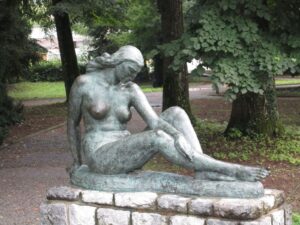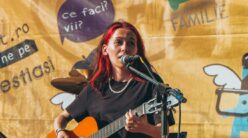
The art history of Croatia is rich, layered, and deeply connected to the country’s social, political, and cultural evolution. From early medieval frescoes to modernist movements and local contemporary artists, Croatia’s visual arts tell a powerful national story.
Medieval to Renaissance Roots
In the medieval period, Croatian art was strongly influenced by religious and ecclesiastical traditions. Frescoes in churches and monasteries across Dalmatia and inland regions captured Biblical scenes, saints, and spiritual themes in a style that blended Romanesque and Gothic forms.
Frescoes of Beram in Istria
As the Renaissance spread northward, Croatia saw the rise of humanist influence in its art. Artists embraced classical motifs, harmony, and proportionality. In architectural and sculptural traditions, towns along the Adriatic coast reflected these Renaissance ideals.
19th–Early 20th Century: National Awakening & Modernism
The 19th century was a period of national awakening in Croatia, and artists played a key role. Vlaho Bukovac is one of the most celebrated painters of this era. After training in Paris, he brought an impressionistic color palette and modern techniques to Zagreb, helping shape a modern Croatian artistic identity.
Another important figure is Mato Celestin Medović, known for historical scenes and vibrant landscapes; his work bridged academic traditions and early modern art trends.
Ivan Tišov, influenced by the Munich Secession, contributed with public murals and religious works, combining local themes and European modernist trends.
20th Century: Socially Engaged Art and Naïve Painting
In the interwar period, the Zemlja (Earth) Group emerged (founded in 1929) with artists who believed art should engage with social realities. They portrayed rural poverty, working-class life, and critiques of society, insisting on authentically local content rather than merely imitating Paris or Berlin trends.
From this socially conscious movement grew the world-renowned Hlebine School of Naïve Art, featuring self-taught painters like Ivan Generalić, Krsto Hegedušić, and others. Their work, rooted in rural life, folklore, and everyday landscapes, became internationally celebrated.
In terms of sculpture and mixed media, artists like Vasko Lipovac (20th century) brought dynamic forms, sculpture, graphic art, and playful abstraction to Croatian art.
Contemporary and Late 20th Century
After World War II and into the late 20th century, Croatian art diversified further. Modernism, abstraction, and conceptual art gained ground. The Institute for Art History documents how Croatian modern art (1898–1975) developed through different movements, responding to changes in society and global art.
In sculpture, post-1950s Croatian artists produced significant work, from public monuments to abstract and experimental pieces.
Daruvar in the Croatian Art Story
Daruvar, a smaller town in Croatia, might not be the first place you think of when it comes to national art history, but it has its own meaningful artistic legacy.
Eva Fischer is perhaps the most internationally known artist from Daruvar. Born in the town, she became a celebrated painter, and in 2022 Daruvar opened the Galerija Eva Fischer in her honor.
The town also has an active Painting Group “DA” Daruvar, founded in 1972. Its members work in oil, watercolor, sculpture, and more, and they host an annual painting colony.
Contemporary local artists include Tanja Čubrilo, born in Daruvar, who works in enkaustika (wax painting) and abstract expressionism.
Another Daruvar native is Vjekoslav “Lavo” Masten, known for his paintings and the ornate frames he builds for his own work, sometimes made with gold or silver leaf.
In 2024, Milka Prodanić held an exhibition in Daruvar titled „Trag u beskraju – umjetnost na svili“ (“Trace into Infinity — Art on Silk”), showcasing her mastery of silk painting.
A public sculpture in Daruvar — the bronze “Kupačica” (Bathing Woman), also known as Gola Maja, was created by the famous Croatian sculptor Antun Augustinčić, and it remains a landmark in the town.
Daruvar also has a tradition in photography: before the 1970s, there were three strong professional photographic studios in the town, and a photo club was established in 1937.
In 2020, Daruvar got its first large mural: tattoo-artist Ivan Molnar painted a public wall with local motifs (ginkgo leaves, stars, the Daruvar castle).
Why It Matters
The story of Croatian art is not just about big names or coastal cultural centers; it’s also rooted in smaller towns like Daruvar. Local artists, community galleries, and public art in places like Daruvar reflect how deeply art is woven into Croatian identity and daily life. They bridge the national and the local, the traditional and the contemporary.
In sum, Croatia’s art history spans centuries: from ecclesiastical frescoes and Renaissance architecture, through socially critical modernism and naïve folk art, to today’s experimental painters and public artists. And Daruvar, though modest in size, plays its part, producing artists who contribute to both local identity and the broader story of Croatian culture.
Author: Raul Havram
*Ovaj je sadržaj izrađen u sklopu projekta koji financira Ministarstvo obrazovanja i mladih Republike Hrvatske. Sadržaj ovog materijala isključiva je odgovornost autora i ne odražava nužno stajališta Ministarstva.






